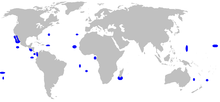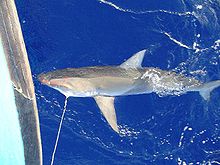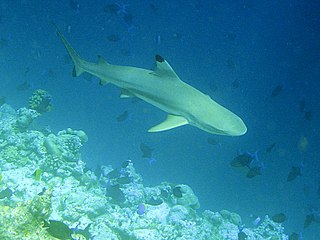
Requiem sharks are sharks of the family Carcharhinidae in the order Carcharhiniformes. They are migratory, live-bearing sharks of warm seas and include such species as the bull shark, lemon shark, spinner shark, blacknose shark, blacktip shark, grey reef shark, blacktip reef shark, silky shark, dusky shark, blue shark, copper shark, oceanic whitetip shark, and whitetip reef shark.

The grey reef shark or gray reef shark is a species of requiem shark, in the family Carcharhinidae. One of the most common reef sharks in the Indo-Pacific, it is found as far east as Easter Island and as far west as South Africa. This species is most often seen in shallow water near the drop-offs of coral reefs. It has the typical "reef shark" shape, with a broad, round snout and large eyes. It can be distinguished from similar species by the plain or white-tipped first dorsal fin, the dark tips on the other fins, the broad, black rear margin on the tail fin, and the lack of a ridge between the dorsal fins. Most individuals are less than 1.88 m (6.2 ft) long.
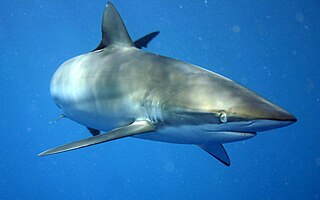
The silky shark, also known by numerous names such as blackspot shark, gray whaler shark, olive shark, ridgeback shark, sickle shark, sickle-shaped shark and sickle silk shark, is a species of requiem shark, in the family Carcharhinidae, named for the smooth texture of its skin. It is one of the most abundant sharks in the pelagic zone, and can be found around the world in tropical waters. Highly mobile and migratory, this shark is most often found over the edge of the continental shelf down to 50 m (164 ft). The silky shark has a slender, streamlined body and typically grows to a length of 2.5 m. It can be distinguished from other large requiem sharks by its relatively small first dorsal fin with a curving rear margin, its tiny second dorsal fin with a long free rear tip, and its long, sickle-shaped pectoral fins. It is a deep, metallic bronze-gray above and white below.

The blacktip reef shark is a species of requiem shark, in the family Carcharhinidae, which can be easily identified by the prominent black tips on its fins. Among the most abundant sharks inhabiting the tropical coral reefs of the Indian and Pacific Oceans, this species prefers shallow, inshore waters. Its exposed first dorsal fin is a common sight in the region. The blacktip reef shark is usually found over reef ledges and sandy flats, though it has also been known to enter brackish and freshwater environments. It typically attains a length of 1.6 m (5.2 ft). Like other sharks, the females are larger than the males.
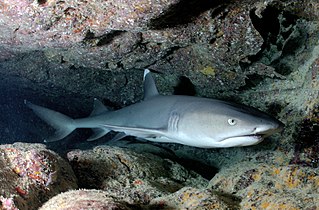
The whitetip reef shark is a species of requiem shark, in the family Carcharhinidae, and the only member of its genus. A small shark that does not usually exceed 1.6 m (5.2 ft) in length, this species is easily recognizable by its slender body and short but broad head, as well as tubular skin flaps beside the nostrils, oval eyes with vertical pupils, and white-tipped dorsal and caudal fins. One of the most common sharks found on Indo-Pacific coral reefs, the whitetip reef shark occurs as far west as South Africa and as far east as Central America. It is typically found on or near the bottom in clear water, at a depth of 8–40 m (26–131 ft).

The copper shark, bronze whaler, or narrowtooth shark is a species of requiem shark found mostly in temperate latitudes. It is distributed in a number of separate populations in the northeastern and southwestern Atlantic, off southern Africa, in the northwestern and eastern Pacific, and around Australia and New Zealand, with scattered reports from equatorial regions. The species can be found from brackish rivers and estuaries to shallow bays and harbors, to offshore waters 100 m (330 ft) deep or more. Females are found apart from males for most of the year, and conduct seasonal migrations. A large species reaching 3.3 m (11 ft) long, the copper shark is difficult to distinguish from other large requiem sharks. It is characterized by its narrow, hook-shaped upper teeth, lack of a prominent ridge between the dorsal fins, and plain bronze coloration.

The dusky shark is a species of requiem shark, in the family Carcharhinidae, occurring in tropical and warm-temperate continental seas worldwide. A generalist apex predator, the dusky shark can be found from the coast to the outer continental shelf and adjacent pelagic waters, and has been recorded from a depth of 400 m (1,300 ft). Populations migrate seasonally towards the poles in the summer and towards the equator in the winter, traveling hundreds to thousands of kilometers. One of the largest members of its genus, the dusky shark reaches more than 4 m (13 ft) in length and 350 kg (770 lb) in weight. It has a slender, streamlined body and can be identified by its short round snout, long sickle-shaped pectoral fins, ridge between the first and second dorsal fins, and faintly marked fins.

The silvertip shark is a large species of requiem shark, in the family Carcharhinidae, with a fragmented distribution throughout the tropical Indian and Pacific Oceans. It is often encountered around offshore islands and coral reefs, and has been known to dive to a depth of 800 m (2,600 ft). The silvertip shark resembles a larger and bulkier grey reef shark, but can be easily identified by the prominent white margins on its fins. It attains a maximum length of 3 m (10 ft).

The blacktip shark is a species of requiem shark, and part of the family Carcharhinidae. It is common to coastal tropical and subtropical waters around the world, including brackish habitats. Genetic analyses have revealed substantial variation within this species, with populations from the western Atlantic Ocean isolated and distinct from those in the rest of its range. The blacktip shark has a stout, fusiform body with a pointed snout, long gill slits, and no ridge between the dorsal fins. Most individuals have black tips or edges on the pectoral, dorsal, pelvic, and caudal fins. It usually attains a length of 1.5 m (4.9 ft).

The Caribbean reef shark is a species of requiem shark, belonging to the family Carcharhinidae. It is found in the tropical waters of the western Atlantic Ocean from Florida to Brazil, and is the most commonly encountered reef shark in the Caribbean Sea. With a robust, streamlined body typical of the requiem sharks, this species is difficult to tell apart from other large members of its family such as the dusky shark and the silky shark. Distinguishing characteristics include dusky-colored fins without prominent markings, a short free rear tip on the second dorsal fin, and tooth shape and number.

The blacknose shark is a species of requiem shark, belonging to the family Carcharhinidae, common in the tropical and subtropical waters of the western Atlantic Ocean. This species generally inhabits coastal seagrass, sand, or rubble habitats, with adults preferring deeper water than juveniles. A small shark typically measuring 1.3 m (4.3 ft) long, the blacknose has a typical streamlined "requiem shark" shape with a long, rounded snout, large eyes, and a small first dorsal fin. Its common name comes from a characteristic black blotch on the tip of its snout, though this may be indistinct in older individuals.

The bignose shark is a species of requiem shark, in the family Carcharhinidae. Distributed worldwide in tropical and subtropical waters, this migratory shark frequents deep waters around the edges of the continental shelf. It is typically found at depths of 90–430 m (300–1,410 ft), though at night it may move towards the surface or into shallower water. The bignose shark is plain-colored and grows to at least 2.7–2.8 m (8.9–9.2 ft) in length. It has a long, broad snout with prominent nasal skin flaps, and tall, triangular upper teeth. Its pectoral fins are long and almost straight, and there is a ridge on its back between the two dorsal fins.

The hardnose shark is a species of requiem shark, in the family Carcharhinidae, so named because of the heavily calcified cartilages in its snout. A small bronze-coloured shark reaching a length of 1.1 m (3.6 ft), it has a slender body and a long, pointed snout. Its two modestly sized dorsal fins have distinctively elongated rear tips. The hardnose shark is widely distributed in the western Indo-Pacific, from Kenya to southern China and northern Australia. It inhabits warm, shallow waters close to shore.

The spinner shark is a type of requiem shark, in the family Carcharhinidae, named for the spinning leaps it makes as a part of its feeding strategy. This species occurs in tropical and warm temperate waters worldwide, except for in the eastern Pacific Ocean. It is found from coastal to offshore habitats to a depth of 100 m (330 ft), though it prefers shallow water. The spinner shark resembles a larger version of the blacktip shark, with a slender body, long snout, and black-marked fins. This species can be distinguished from the blacktip shark by the first dorsal fin, which has a different shape and is placed further back, and by the black tip on the anal fin. It attains a maximum length of 3 m (9.8 ft).
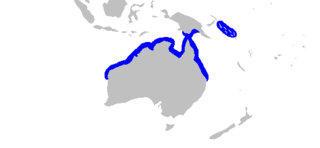
The nervous shark is a species of requiem shark, and part of the family Carcharhinidae, so named because of its timid behavior in regard to humans. It is common in shallow, coastal waters off northern Australia, Papua New Guinea, and the Solomon Islands. A small brownish or grayish shark typically measuring 1.0–1.3 m (3.3–4.3 ft) long, this species has a short, blunt snout, oval eyes, and a relatively large second dorsal fin. The leading margins of most fins are finely edged with black, and the lower caudal fin lobe is black-tipped.

The finetooth shark is a species of requiem shark, in the family Carcharhinidae, found in the western Atlantic Ocean, from North Carolina to Brazil. It forms large schools in shallow, coastal waters, and migrates seasonally following warm water. A relatively small, slender-bodied shark, the finetooth shark can be identified by its needle-like teeth, dark blue-gray dorsal coloration, and long gill slits. It attains a maximum length of 1.9 m (6.2 ft). The diet of this species consists primarily of small bony fishes, in particular menhaden. Like other members of its family, it is viviparous with females giving birth to two to six pups in estuarine nursery areas every other year.

The smoothtooth blacktip shark is a species of requiem shark in the family Carcharhinidae. It is known only from the type specimen caught from the Gulf of Aden, off eastern Yemen, and a handful of additional specimens caught from the Persian Gulf, off Kuwait. Reaching 1.3 m (4.3 ft) in length, this species has a stocky greenish-colored body, a short snout, and black-tipped fins. It can be distinguished from similar species by its teeth, which are narrow, erect, and smooth-edged.

The smalltail shark is a species of requiem shark, and part of the family Carcharhinidae. It is found in the western Atlantic Ocean, from the northern Gulf of Mexico to southern Brazil. It inhabits shallow waters close to shore, particularly over muddy bottoms around estuaries. It tends to swim low in the water column and forms large aggregations segregated by sex. A slim species generally not exceeding 1.1 m (3.6 ft) in length, the smalltail shark has a rather long, pointed snout, a broad, triangular first dorsal fin, and a second dorsal fin that originates over the midpoint of the anal fin base. It is plain gray in color, without prominent markings on its fins.

The blackspot shark is a small species of requiem shark in the family Carcharhinidae found in the tropical Indo-West Pacific Ocean between latitudes 24°N and 30°S, from the surface to a depth around 40 m (130 ft). Its length is a little under one meter (yard) and it is not considered to be dangerous to humans. It feeds mainly on fish, crustaceans, and squid. This shark is also caught in small-scale fisheries for human consumption.

The spot-tail shark, or sorrah shark, is a species of requiem shark, in the family Carcharhinidae, found in the tropical Indo-West Pacific Ocean between latitudes 31°N and 31°S from the surface to a depth around 72 m (236 ft). This shark grows to about 1.6 m. It is fished commercially over much of its range and the IUCN considers it to be near threatened.

